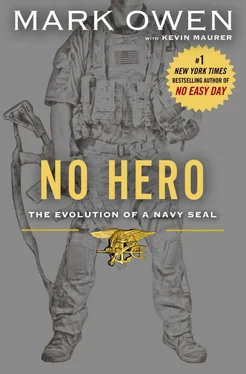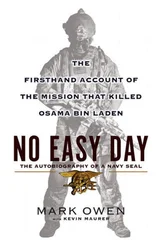“If you want to stay in this training, you’re going to have to do this swim,” the instructor told us as we huddled on the deck. “The key is to stay as relaxed as you can.”
The swim wasn’t timed. Swim fifty meters in the twelve-foot-deep pool—down and back in one breath. Safety swimmers were positioned above and below us as we swam. Doctors and an ambulance waited poolside in case of emergency.
The test was simple, on paper. But that was before the instructors took away any advantages. No diving off the wall. We had to step out far enough to do a front flip underwater, so once you started toward the far end of the pool you had no forward momentum.
The underwater swim was part of the first phase of BUD/S, which includes a grueling five-and-a-half-day stretch called Hell Week. During Hell Week, each candidate sleeps only about four total hours but runs more than two hundred miles and does physical training for more than twenty hours per day.
BUD/S is all about training your mind and body to achieve more than you think possible. It is the first test in a SEAL’s training and career. The SEAL motto, “The only easy day was yesterday,” was about to become very clear to us.
I don’t think I realized it at the time, but BUD/S is a series of building blocks starting with the fifty-meter swim and Hell Week in the first phase, followed by dive training in the second phase, and then firearms and explosives training in the final phase. Basically, you start with baby steps and end up doing the things that can kill you if not handled correctly. You have to pass each one to keep going. Fail once and you wash out.
I knew, coming from Alaska, that swimming was going to be my weakest skill. My SEAL buddy in college taught me the breaststroke and the sidestroke, which is all I needed. And for one semester, I worked out with my college club team. But of all the tests in BUD/S, this one worried me. I knew it was all or nothing. I knew no matter how tired, nervous, or scared I was, I couldn’t let doubt creep into my head. I had to make it.
After the safety briefing, we sat in lines—nut to butt, as we say—in our tan shorts. Over my shoulder, I could hear splashes as my classmates jumped into the pool. The night before, guys had been full of tips and advice. We’d talked about trying to stay deep. I didn’t want to be a foot underwater, because I might be tempted to poke my head up. I had decided to try to stay at six or seven feet.
There was no talking as I waited for my name to be called. A few minutes before I stepped to the edge of the pool, I took two deep breaths. I wanted to slow everything down in my mind in an attempt to relax and focus.
“This is easy,” I told myself as I walked to the edge of the pool. “All the instructors did it. It’s not impossible. Chill out.”
When it was my turn to go, I stepped feetfirst into the pool and disappeared under the surface. I pushed my head down and kicked my legs over into a flip. I could feel the water surge up my nose, forcing me to blow out some of my last breath. I was uncomfortable from the start.
I pushed my hands up and using the breaststroke started toward the far end of the pool. It looked more than twenty-five meters away. I knew the test was a battle of distance, not time. I didn’t hurry. Instead, I concentrated on slow, deliberate strokes. There is a saying, “Slow is smooth and smooth is fast.” I was living proof as I glided below the surface.
I felt good physically, but I couldn’t stop my mind from thinking about how far away the wall looked. At the bottom of the pool, I spotted one of the instructors. He had a regulator in his mouth connected to a scuba tank. I watched as he tracked us from the bottom, ready to spring up and rescue one of us if we started to drown.
Above me, another instructor with a scuba mask and snorkel kept pace. He looked like a predator ready to dive after his prey.
The whole swim takes only forty seconds to a minute, but it felt a lot longer. My lungs kept reminding me I needed air and my mind was begging me to surface. As I reached the wall, I spun around and set my legs to push with all my might. It felt good to have some momentum heading back to where I started.
By now, the burning in my lungs was impossible to ignore. I knew I’d be “chicken necking” soon. That is the first step before you pass out. Think of it as a gag reflex. I could feel my head start to bob as my body tried to force me to breathe. The first feelings of panic started to tingle, but I quickly pushed them deeper into my mind. Instead, I focused on my slow, deliberate stroke, as the wall grew larger and larger.
“Just keep swimming,” I pleaded with myself. “Keep swimming.”
But I couldn’t stop the gasping. It wasn’t mental. It was my body in revolt. My lungs were on fire, threatening to come out of my chest. My mind started to panic and my focus began to wane. It isn’t natural to deny your body air. We’re hardwired to survive, and we need air to do it.
But I fought to get control of my mind. I focused on the ever-growing far wall. I committed to staying underwater. I refused to give up. This was the first real test. If I couldn’t do this in a clean, heated pool in sunny San Diego, what was I going to do in the North Atlantic during a storm?
The chicken necking eventually stopped, and with each stroke, I got closer to the wall. But I could also feel myself losing consciousness. My vision blurred around the edges. With each stroke, the darkness started to crowd my vision. Like a fog, the shadow started in my peripheral vision and I knew in a few seconds I might pass out.
I had to be near the wall. I reached out to touch it. Rough hands grabbed me under my arms. The instructors pulled me out of the water like a trophy fish. I flopped down on the pool deck and took a deep breath. I could feel my lungs draw in deep, and my body relaxed. I took several more deep breaths and then tried to get up.
“Stay down,” I heard one of the instructors bark at me.
I rested my head back on the warm deck. It’s rare for instructors in BUD/S to let you rest, and I was going to take full advantage. One by one my classmates finished. I watched the instructors throw the limp body of one of my classmates up onto the deck. He was out cold. After a few quick breaths, he gagged and coughed his way back to consciousness. The minute he did, he looked at the nearest instructor.
“Did I make it?”
The fact that seconds before, he was unconscious seemed like a minor detail. I understood because, like him, I didn’t want to fail. Failure was almost worse than death.
“Stay down,” an instructor said. “Relax.”
I was enjoying the sun on my back. It was paradise, for a few seconds. The instructors saw I was fine.
“Get the fuck up and head over to the pass line. You did it.” Those were great words to hear.
No one who makes it through BUD/S ever thought he’d fail. BUD/S is relentless and forced me to dig deep. I never doubted myself. I knew I’d pass. I think people mistake a SEAL’s confidence for arrogance. But after the fifty-meter swim, Hell Week, and dive training, where the instructors do their best to drown you, we know our limits and we know how to push well beyond them. During BUD/S I overcame dozens of obstacles that looked insurmountable at the time, and that gave me the confidence to know I could do it again.
But bobbing in the near-freezing river in Alaska, I had to work hard to muster that confidence. I wasn’t sure I could do this, but tied to my buddy and nearing the opening to the pier, I didn’t have a lot of choice.
It took only a few minutes before I couldn’t feel my face. We let the current push us toward the harbor. At its widest the Ketchikan Creek is only about twenty feet and only five feet deep, so we bobbed at the surface until we crossed the first bridge. We were using Draeger diving rigs, which use pure oxygen. There are no bubbles when we exhale, keeping us much quieter.
Читать дальше










